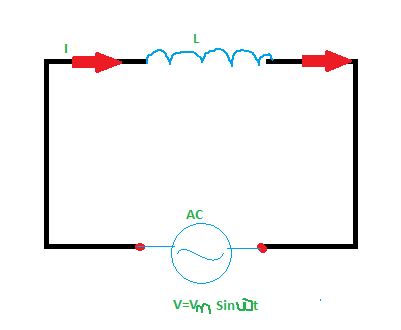
In a pure inductive circuit or in an AC circuit containing inductance only, the current
A. Lead the e.m.f by${90^ \circ }$
B. Lags behind the e.m.f by ${90^ \circ }$
C. sometimes leads and sometime lags behind the e.m.f
D. Is in the phase with the e.m.f
Answer
504k+ views
Hint: A current that changes its magnitude and polarity at regular intervals is known as alternating current. It can also be described as an electrical current that alternates or reverses its direction on a regular basis, as opposed to Direct Current (DC), which only flows in one direction.
Complete step-by-step solution:
Before going through the question let us first know about inductance and pure inductive circuit.
Inductance: The tendency of an electrical conductor to resist a change in the electric current flowing through it is known as inductance in electromagnetism and electronics. A magnetic field is generated around a conductor by the movement of electric current.
$L = \dfrac{{\phi \left( i \right)}}{i}$
Where, L= Inductance
$\phi $ = Magnetic flux of current \[\left( {{\text{ }}i} \right)\] and
\[\left( {{\text{ }}i} \right)\] = current
Pure Inductive Circuit: The tendency of an electrical conductor to resist a change in the electric current flowing through it is known as inductance in electromagnetism and electronics. A magnetic field is generated around a conductor by the movement of electric current.
Now coming to the question, The term "pure inductive circuit" refers to a circuit that includes only inductance (L) and no other quantities such as resistance or capacitance.

In this type of circuit, the current is 90 degrees behind the voltage. Present lags voltage in circuits with mostly inductive loads. This occurs because the current flows in an inductive load due to the induced electromotive force. The current is provided by the voltage in the description above.
So, the correct option is: b. Lags behind the e.m.f by ${90^ \circ }$.
Note:An LCR metre is a piece of electronic test equipment that measures an electronic component's inductance (L), capacitance (C), and resistance (R). The impedance was calculated internally in earlier models of this instrument and translated to the corresponding capacitance or inductance value for display.
Complete step-by-step solution:
Before going through the question let us first know about inductance and pure inductive circuit.
Inductance: The tendency of an electrical conductor to resist a change in the electric current flowing through it is known as inductance in electromagnetism and electronics. A magnetic field is generated around a conductor by the movement of electric current.
$L = \dfrac{{\phi \left( i \right)}}{i}$
Where, L= Inductance
$\phi $ = Magnetic flux of current \[\left( {{\text{ }}i} \right)\] and
\[\left( {{\text{ }}i} \right)\] = current
Pure Inductive Circuit: The tendency of an electrical conductor to resist a change in the electric current flowing through it is known as inductance in electromagnetism and electronics. A magnetic field is generated around a conductor by the movement of electric current.
Now coming to the question, The term "pure inductive circuit" refers to a circuit that includes only inductance (L) and no other quantities such as resistance or capacitance.

In this type of circuit, the current is 90 degrees behind the voltage. Present lags voltage in circuits with mostly inductive loads. This occurs because the current flows in an inductive load due to the induced electromotive force. The current is provided by the voltage in the description above.
So, the correct option is: b. Lags behind the e.m.f by ${90^ \circ }$.
Note:An LCR metre is a piece of electronic test equipment that measures an electronic component's inductance (L), capacitance (C), and resistance (R). The impedance was calculated internally in earlier models of this instrument and translated to the corresponding capacitance or inductance value for display.
Recently Updated Pages
Master Class 12 Economics: Engaging Questions & Answers for Success

Master Class 12 Maths: Engaging Questions & Answers for Success

Master Class 12 Biology: Engaging Questions & Answers for Success

Master Class 12 Physics: Engaging Questions & Answers for Success

Master Class 8 Maths: Engaging Questions & Answers for Success

Class 8 Question and Answer - Your Ultimate Solutions Guide

Trending doubts
What is meant by exothermic and endothermic reactions class 11 chemistry CBSE

10 examples of friction in our daily life

One Metric ton is equal to kg A 10000 B 1000 C 100 class 11 physics CBSE

1 Quintal is equal to a 110 kg b 10 kg c 100kg d 1000 class 11 physics CBSE

Difference Between Prokaryotic Cells and Eukaryotic Cells

What are Quantum numbers Explain the quantum number class 11 chemistry CBSE




